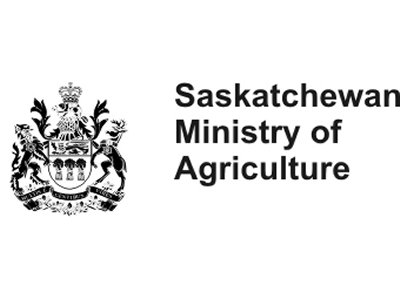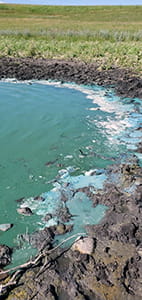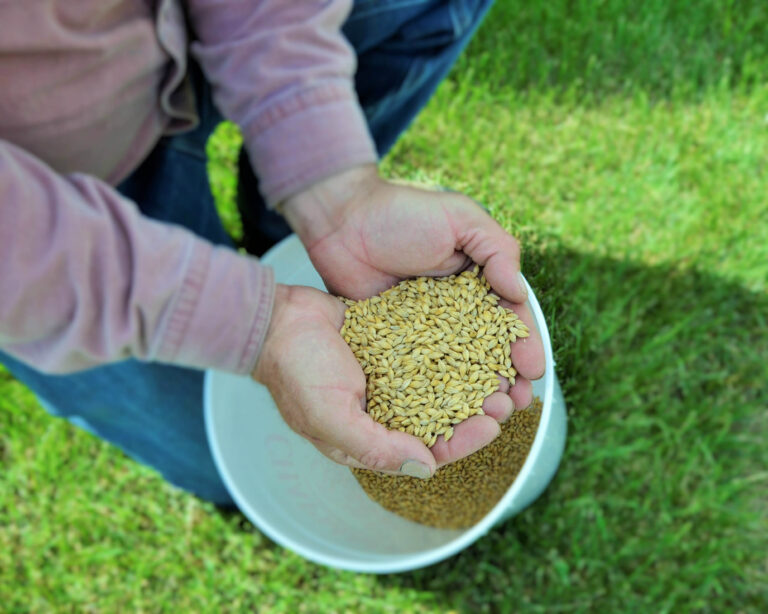by Maddy Lazurko
Ministry of Agriculture
Picking the right mineral for your cattle is essential year-round, but especially during hot summer months. When water has a moderate to high sulfate content, some risks can be mitigated by mineral selection. Sulfate levels increase throughout the summer when conditions are dry. A summer mineral program is important to ensure cows have the adequate nutrients to rebreed and remain healthy. After choosing the correct mineral blend, it is vital to also consider mineral quality.
In cattle diets, macro minerals are required in relatively large amounts. The main macro minerals are calcium, chlorine, magnesium, sulfur, sodium, phosphorus and potassium. Most mineral packages are balanced for calcium and phosphorus and, for cattle, the recommended calcium to phosphorus ratio is greater than or equal to 2:1. To achieve this ratio, different blends are needed to accompany different forages. Cattle require a 1:1 mineral on high legume rations and a 2:1 or 3:1 mineral on pasture or grass forage.
Trace minerals are required in smaller amounts in the diet. This group includes copper, iron, selenium, cobalt, iodine, manganese and zinc. The availability of trace minerals is dependent on their form and the presence of any anti-nutritional factors in the diet. The most common anti-nutritional factor in the summer is an excess of sulfates in the water.
Trace minerals come in three main forms: oxides, sulfates and chelates. The more easily a mineral is absorbed in the small intestine, the better. Oxides are the most stable form of trace minerals and have the lowest absorption rate. Sulfates are the most common form and have an intermediate absorption rate. Chelates are the most available form to the animal and are readily absorbed in the small intestine.
Supplementing with chelated minerals can offset the negative effects of moderate sulfate concentrations in the water. When high sulfate water is consumed by cattle, the sulfates bind to trace minerals in the rumen. The mineral then travels to the small intestine where it is too large to be absorbed, passing through the digestive tract and into the manure. The inability of the animal to absorb trace minerals will cause a mineral deficiency where the animal’s fertility, growth and immune status are impacted. In severe cases, high sulfate concentrations can impact the animal’s ability to produce thiamin, resulting in the development of polio.
Chelated minerals are protected and less likely to bind with sulfates. Chelates can pass through the rumen into the small intestine for absorption. It is important to note that the effects of sulfate levels above 2,000 mg/L cannot be mitigated by the use of chelated minerals.
Improperly managed and monitored water sources can lead to a dangerously high sulfur load, causing a compromised mineral status in the herd. Chelated minerals can help mitigate this risk. For advice on implementing or adjusting a mineral program for your herd in dry summer grazing conditions, contact the Agriculture Knowledge Centre at 1-866-451-2377 to be connected with your regional livestock and feed extension specialist.
Chelated minerals as a mitigation strategy for sulfate contaminated water
Weekly crop report
Province of Saskatchewan
Submitted
Producers have made tremendous progress last week with 74 per cent of the 2021 crop now seeded, well ahead of the five-year average of 48 per cent (2016-2020) for this time of year.
Minimal rain and fair weather across the province has allowed producers to seed without any prolonged delays.
Eighty-two per cent of the crop has been seeded in the southwest region. Seventy-nine per cent has been seeded in the southeast, 77 per cent seeded in both the west-central and northwest regions and 63 per cent seeded in the east-central and northeast regions.
Ninety-three per cent of the field peas, 93 per cent of the lentils, 83 per cent of the durum, 83 per cent of the chickpeas, 80 per cent of the spring wheat, 78 per cent of the canola and 75 per cent of the barley have been seeded to date.
There was scattered rainfall throughout most regions in the province this week. The Tisdale area received the highest amount at 25 mm thanks to a thunderstorm. The Christopher Lake area received 13 mm and the Pelly area received 10 mm.
The rain is welcomed but more is needed to address the current extremely dry conditions throughout the province.
Limited precipitation and warm windy conditions throughout the province have further reduced topsoil moisture conditions. Cropland topsoil moisture is rated as zero per cent surplus, 20 per cent adequate, 48 per cent short and 32 per cent very short. Hay and pasture land topsoil moisture is rated as zero per cent surplus, 13 per cent adequate, 36 per cent short and 50 per cent very short.
Some farmers have halted seeding canola while they wait for rain in the forecast. Others have opted to seed wheat or other cereals instead. Very little spraying is happening in the province due to low weed emergence and strong winds making for poor spraying conditions. For many parts of the province where precipitation has been very low, crop germination has been poor and patchy.
Northeastern Saskatchewan
Fair weather has allowed producers to make great progress with seeding with 63 per cent of the 2021 crop in the ground, which is above the five-year average (2016-2020) for this time of year of 22 per cent.
Ninety-eight per cent of the field peas, 96 per cent of the spring wheat, 80 per cent of the canary seed, 77 per cent of the barley, 77 per cent of the oats, 62 per cent of the flax and 50 per cent of the canola has been seeded to date.
With the wildfire in the Prince Albert area and windy conditions, some crop reporters have noted large amounts of smoke in their areas. Windy conditions have also prevented some producers from spraying. There was a thunderstorm in the Tisdale area that resulted in 25 mm of rain in a localized area. The Christopher Lake area received 13 mm, the Lake Lenore area got five mm and the Kinistino area received four mm.
Cropland topsoil moisture is rated as zero per cent surplus, 60 per cent adequate, 30 per cent short and ten per cent very short. Hay land and pasture topsoil moisture is rated as zero per cent surplus, 58 per cent adequate, 30 per cent short and 12 per cent very short.
Producers are spraying weeds that have emerged, rock picking, harrowing and tending to their cattle.
Northwestern Saskatchewan
Producers in the northwest have made further progress with 77 per cent currently seeded. This is ahead of the five-year average (2016-2020) of 31 percent for this time of year. Within the region 95 per cent of the field peas, 85 per cent of the lentils, 84 per cent of the spring wheat, 75 per cent of the durum, 73 per cent of the barley and 73 per cent of the canola are seeded to date.
The region received very little precipitation in the form of scattered showers during the week. The North Battleford and Turtleford areas received the highest amount of precipitation in the region with around two mm. The Mayfair and Frenchmen Butte areas received one mm.
Warm temperatures and little rain over the past week have allowed the soil moisture conditions to deteriorate.
Cropland topsoil moisture is rated as zero per cent surplus, six per cent adequate and 70 per cent short and 24 per cent very short. Hay land and pasture topsoil moisture is rated as zero per cent surplus, zero per cent adequate, 75 per cent short and 25 per cent very short.
Producers are busy seeding, harrowing and spaying weeds.
Managing blue-green algae to promote a healthy dugout
by Alexis DeCorby
Saskatchewan Ministry of Agriculture
Algae and bacteria commonly occur in dugouts. Fortunately, there are several ways to control algae levels in your surface water. While not all algae types are toxic to livestock, blue-green algae (Cyanobacteria), can pose a risk. Algal blooms are not toxic to humans or animals. Blue-green algae’s name is misleading, because it is not algae, but a bacterium, known as Cyanobacteria. Common toxicity symptoms associated with blue-green algae include weakness, staggering, difficulty breathing and convulsions.
Development of Blue-Green Algae
Like most algae, blue-green algae thrives in stagnant water, such as dugouts. Light and nutrients (particularly phosphorus and nitrogen) are required for growth and we typically see algae blooms in the warm summer months. While not all blue-green algae produce a toxic bloom, it is impossible to tell which will be toxic visually. Always err on the side of caution if you believe blue-green algae is present.
Identifying Blue-Green Algae
Blue-green algae is characterized by its shiny, reflective appearance. In some cases, the dugout may look like pea soup, spilled paint floating on top or even varying colors of red or yellow. One way to determine if you have blue-green algae is to try to scoop some into your hand. If there are green particles (similar to grass clippings) that stick to your hand or slip through your fingers, it’s most likely blue-green algae. Filamentous algae will be long and stringy in comparison.
Treating Blue-Green Algae
The treatment method discussed is applicable for non-draining waterbodies such as dugouts, that are on private land. If the waterbody drains to adjacent areas or waterways, a permit for chemical control of aquatic nuisances is required from the Saskatchewan Ministry of Environment. Blue-green algae can be treated with any registered product, typically containing copper sulphate. Be sure to follow all label directions and application instructions. When the bloom dies, either by treatment or natural disturbance to the water, that is when it typically releases its toxins. It is recommended that producers wait 12 to 14 days before allowing livestock to consume any water from that source, to allow the toxins to dissipate.
Preventing Blue-Green Algae
The most cost effective method to controlling algae is prevention. Keeping water moving through aeration prevents warm water from building up near the top of the water body where algal blooms would form. Additionally, reducing or eliminating the amount of nutrients from runoff, fertilizer and livestock excrement from entering the dugout can limit the nutrients needed for algae growth. Having healthy riparian areas and excluding direct access by livestock to the source are just a few options to reduce or eliminate these nutrients.
Preventing, monitoring and treating algae in dugouts as needed is one component to keeping your water sources safe for livestock consumption. For more information on this topic, or any other livestock related questions, please contact your local livestock and feed extension specialist or call the Agriculture Knowledge Centre at 1-866-457-2377.
Recapping Canadian Agriculture Day
by Rachel Kraynick
Saskatchewan Ministry of Agriculture
Canada’s Agriculture Day was held on February 23, 2021. This year’s theme was “Forks Up” which encouraged participants to celebrate Canadian food and the agriculture industry. Saskatchewan has a lot to celebrate, being home to more than 40 per cent of Canada’s cultivated farmland and some of the most productive land in the world. Our province is the world’s largest exporter of peas, lentils, durum wheat, mustard seed, canola, flaxseed and oats and is the second largest cattle-producing province in Canada. We are home to more than 300 food processing companies, the Protein Industries Canada supercluster and the Saskatchewan Food Centre. Our province is filled with innovative producers and early adopters of commercial technology who have led the way in maximizing the province’s agricultural productivity.
The Ministry of Agriculture celebrated this day by hosting a provincial photo contest where individuals submitted their agriculture photos. We received over 200 photos. Thank you to everyone who took part in the contest. You may see these photos appear in our ministry’s social media posts, print publications or staff presentations and the winner will be featured in October’s edition of Agriview.
We also hosted a celebration challenge that engaged 1,850 students from across the province. Students that participated in the day received plantable bookmarks. These bookmarks were filled with carrot seeds and could be used as a bookmark or seeded into soil to sprout some tasty snacks. Yorkton’s Grain Millers graciously sponsored the bookmarks for our challenge and Agriculture in the Classroom helped us connect to classrooms across the province, encouraging the students to find creative ways to celebrate agriculture.
Our challenge included students from Kindergarten to Grade 9, rural and urban, and here are a few examples of how they chose to celebrate:
- We drew pictures about what agriculture meant to us and put them around the community! We wrote letters to the family members who are our food heroes!
Mrs. Rachul Kindergarten class – Delisle Early Learning, Delisle - We have been growing peas, canola and wheat in our classroom in preparation for Agriculture Day!
Mrs. Potter Grade 1 – Ecole St. Isidore School, Bellevue - We created a large poster about the importance of Canadian agriculture. The students worked together as a class to research and learn what the word “agriculture” means and the many ways that agriculture is a part of their lives. We look forward to growing our bookmarks!
Ms. Mcintosh Grades 1-4 – Lajord Colony, White City - We celebrated Canada’s Agriculture Day by studying Canada’s Food Guide. We used our “What’s in your Lunchbox” resource and several agriculture story books from our friends at Agriculture in the Classroom. We explored Canadian Farms by taking the “FarmFood 360” virtual tours online to learn where our food comes from.
Mrs. Matiko Grade 2/3 class – Lakeview School, Saskatoon - We made butter and are learning all about crops and early settler farming practices in Saskatchewan!Mrs. Wagman Grade 3/4 – Gladys McDonald, Regina
- We posted a forks up photo on social media!
Mrs. Campbell Grade 4 class – St. Josephs School, Lloydminster - We dressed like farmers and ranchers and investigated how technology is impacting farming. We investigated “farm to fork”, read books on agriculture, watched Saskatchewan’s Stewardship Journey and are writing letters to our food heroes.
Mrs. Rosvold Grade 4 – Tisdale - We baked bread and made butter in class. We sent letters to farmers in our local area thanking them for the work they do!
Mrs. Siwak Grade 6 – Riverside Public School, Prince Albert - We are planting different types of plants and work through the scientific method with the plants. We are also planting “tomatosphere” seeds.
Mrs. Barton and Mr. Depape Grade 9 – Sacred Heart School, Yorkton
Even though February 23 is the day dedicated to celebrating the food we love and the people who produce it, we hope everyone continues to celebrate our agriculture industry and all those that work so hard to keep food on our plates.
Demystifying seeding rates
by Kim Stonehouse
Saskatchewan Ministry of Agriculture
In grain production there are many calculations that are critical to the success of any crop. One that is both important and often misunderstood is the seeding rate calculation. This calculation ensures an optimal plant stand is achieved.
Research has shown that for every crop there is a specific target or target range of plant densities (see table) that will be most competitive with weeds. Planting crops at a sufficient rate to achieve this range will also reduce tillering to optimise fungicide timing, even out ripening and unify grain characteristics. All of these factors combined will allow each crop to realize a maximum yield potential, given the growing conditions of the season. Overall, seeding within the optimal range will ensure a foundation that has the best chance of achieving the greatest possible outcome.
Calculation of the correct seeding rate requires knowledge of four factors: target plant density, thousand kernel weight (TKW), germination and expected seedling survival. Once these are known you can use this calculation:
| Seeding rate (kg/ha) = | (target density(Plants/m2) x TKW(g) x 100) |
| (% Germination x % Expected seedling survival) |
Germination and TKW should be given on the seed tag for each seed lot. If not, a simple call to the seed supplier will get this information. In the case of farm-saved seed, submitting a sample to a seed lab for testing will determine these values. Both germination and TKW can vary significantly for different varieties and seed lots. Knowing and applying these values will go a long way to achieving the optimal plant density.
A number of publications and websites can provide target plant stand information. Depending on the source, crop and the units they are described in, target plant stand may be expressed as a single value or a range of values. If the value is given as a range and there are no previous in-field observations to support increasing or decreasing the amount; a good place to start will be right in the middle. Monitoring plant stands by doing some simple plant counts will allow for fine-tuning in future years.
Of all the factors, seedling survival is probably the most mysterious. In order to understand this factor, the elements that affect it need to be examined. Seedling survival depends on seed and plant vigour, soil moisture and temperature as well as the level and type of diseases present. For this reason, it is always given as a range. Some acceptable ranges are: 80 to 90 per cent for cereals with germination, greater than 90 per cent in good conditions, 40 to 60 per cent for oil seeds and 80 to 95 per cent for pulses depending on conditions. As with target plant stand, a good place to start when picking a seedling survival value is right in the middle. Again, this number can be fine-tuned with experience, adjusted up for years that have good planting conditions with good quality seed and down when conditions and seed quality are less than ideal.
Ultimately, seeding rate calculations are very simple, but choice of values to complete the equation is dependent on experience and conditions for each farm. Starting in the middle of each range for each crop will allow for adjustments up or down. Small changes in the chosen values from year to year or from field to field will help to fine-tune the calculation to achieve the best results.
For more information about calculating seeding rates, please contact your nearest crops extension specialist or call the Agriculture Knowledge Centre at 1-866-457-2377.




